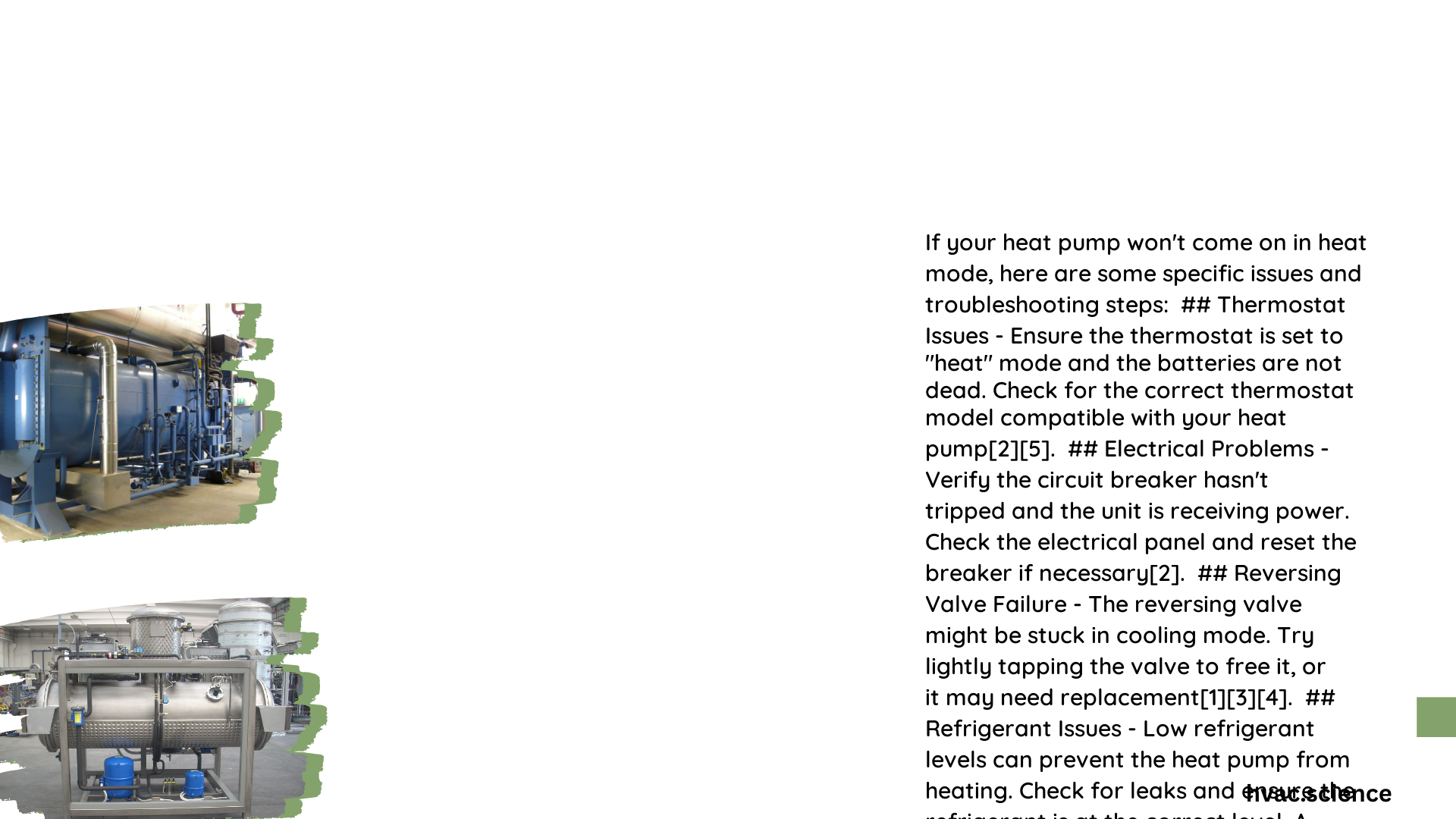When a heat pump fails to operate in heat mode, it can be frustrating and uncomfortable. This issue can stem from various factors, including thermostat settings, electrical problems, or component malfunctions. Understanding the common causes and troubleshooting steps can help homeowners diagnose and potentially resolve the problem, ensuring their heat pump functions properly in heat mode.
Why Won’t My Heat Pump Turn On in Heat Mode?
There are several reasons why your heat pump might not be coming on in heat mode:
- Incorrect thermostat settings
- Power supply issues
- Frozen outdoor unit
- Low refrigerant levels
- Faulty reversing valve
- Dirty air filters
- Tripped circuit breaker or blown fuse
Let’s explore each of these potential causes in more detail.
What Are the Most Common Thermostat Issues?

Thermostat problems are often the culprit when a heat pump won’t come on in heat mode. Here are some common thermostat-related issues:
- Incorrect mode selection: Ensure the thermostat is set to ‘Heat’ mode.
- Temperature setting: The desired temperature should be higher than the current room temperature.
- Fan setting: Set the fan to ‘Auto’ instead of ‘On’ for optimal heating.
- Battery issues: If your thermostat is battery-powered, check and replace the batteries if necessary.
- Wiring problems: Loose or damaged wiring can prevent proper communication between the thermostat and heat pump.
How Do I Check for Power Supply Problems?
Power supply issues can prevent your heat pump from operating in heat mode. Here’s how to check:
- Inspect the circuit breaker panel for any tripped breakers.
- Look for blown fuses in the disconnect box near the outdoor unit.
- Ensure the emergency shut-off switch (usually located near the indoor unit) is in the ‘On’ position.
- Check if other electrical appliances in your home are functioning normally.
If you suspect an electrical problem, it’s best to consult a licensed electrician or HVAC professional.
What Should I Do If the Outdoor Unit Is Frozen?
A frozen outdoor unit can prevent your heat pump from operating effectively. Follow these steps:
- Turn off the heat pump at the thermostat.
- Inspect the outdoor unit for ice buildup.
- If ice is present, allow it to melt naturally. Do not use hot water or sharp objects to remove the ice.
- Once the ice has melted, turn the heat pump back on and monitor its performance.
- If freezing occurs frequently, contact an HVAC professional to check for underlying issues.
How Can I Tell If Refrigerant Levels Are Low?
Low refrigerant levels can cause your heat pump to malfunction. While you can’t directly check refrigerant levels yourself, here are some signs that may indicate a refrigerant issue:
- Insufficient heating
- Ice formation on the outdoor unit
- Hissing or bubbling sounds from the refrigerant lines
- Higher than usual energy bills
If you suspect a refrigerant problem, contact a certified HVAC technician for proper diagnosis and repair.
What Are the Signs of a Faulty Reversing Valve?
The reversing valve is crucial for switching between heating and cooling modes. Signs of a faulty reversing valve include:
- Heat pump blows cold air in heat mode
- System works in cooling mode but not in heating mode
- Unusual noises when switching between modes
A faulty reversing valve requires professional repair or replacement.
How Often Should I Clean or Replace Air Filters?
Dirty air filters can restrict airflow and prevent your heat pump from operating efficiently. Follow these guidelines:
| Filter Type | Cleaning Frequency | Replacement Frequency |
|---|---|---|
| Disposable fiberglass | N/A | Every 30 days |
| Washable | Every 30 days | Every 3-6 months |
| Pleated | N/A | Every 90 days |
| HEPA | N/A | Every 6-12 months |
Regular filter maintenance can improve your heat pump’s performance and efficiency.
What Steps Should I Take to Troubleshoot My Heat Pump?
Follow this step-by-step guide to troubleshoot your heat pump:
- Check thermostat settings
- Inspect circuit breakers and fuses
- Examine the outdoor unit for ice or debris
- Clean or replace air filters
- Listen for unusual noises
- Check for airflow from vents
- Inspect refrigerant lines for signs of leaks
- Reset the system by turning it off for a few minutes, then back on
If these steps don’t resolve the issue, it’s time to call a professional HVAC technician.
When Should I Call a Professional?
While some heat pump issues can be resolved through DIY troubleshooting, certain problems require professional attention. Contact an HVAC technician if:
- You suspect refrigerant leaks
- The system repeatedly trips the circuit breaker
- There are unusual noises or odors coming from the unit
- The heat pump fails to turn on after following troubleshooting steps
- You notice a significant increase in energy bills
Remember, regular maintenance by a qualified technician can prevent many heat pump issues and extend the life of your system.
By understanding these common issues and troubleshooting steps, you can often diagnose and sometimes resolve problems when your heat pump won’t come on in heat mode. However, always prioritize safety and don’t hesitate to call a professional for complex issues or if you’re unsure about any aspect of heat pump maintenance or repair.
References:
1. Mccorry Comfort
2. Cielo Wigle
3. ARS/Rescue Rooter
